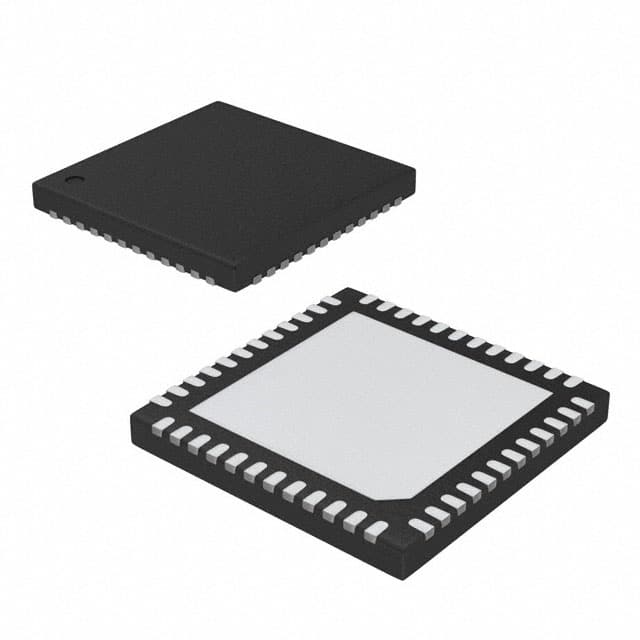MAX16032ETM+ - English Editing Encyclopedia Entry
Product Overview
Category: Integrated Circuits (ICs)
Use: The MAX16032ETM+ is a voltage monitor and reset circuit designed for use in various electronic systems. It provides accurate monitoring of power supply voltages and generates a reset signal when the voltage falls below a specified threshold.
Characteristics: - Monitors up to four power supply voltages simultaneously - Adjustable voltage thresholds for each monitored voltage - Programmable reset timeout period - Low quiescent current consumption - Wide operating voltage range - Small form factor package
Package: The MAX16032ETM+ is available in a 12-pin TDFN (Thin Dual Flat No-Lead) package, which offers excellent thermal performance and compact size.
Essence: The essence of the MAX16032ETM+ lies in its ability to ensure reliable operation of electronic systems by monitoring power supply voltages and generating reset signals when necessary.
Packaging/Quantity: The MAX16032ETM+ is typically sold in reels or tubes containing a specific quantity of units, depending on the manufacturer's packaging standards.
Specifications
- Supply Voltage Range: 1.6V to 5.5V
- Number of Monitored Voltages: Up to 4
- Voltage Threshold Accuracy: ±1.5%
- Reset Timeout Period: Programmable, typically 140ms
- Quiescent Current: 7µA (typical)
- Operating Temperature Range: -40°C to +85°C
Pin Configuration
The MAX16032ETM+ features a 12-pin TDFN package with the following pin configuration:
- VCC - Power Supply Voltage Input
- GND - Ground
- MR - Manual Reset Input
- RESET - Active-Low Reset Output
- V1 - Voltage Monitor Input 1
- V2 - Voltage Monitor Input 2
- V3 - Voltage Monitor Input 3
- V4 - Voltage Monitor Input 4
- CT - Capacitor Connection for Reset Timeout
- GND - Ground
- RESET - Active-Low Reset Output
- VCC - Power Supply Voltage Input
Functional Features
- Accurate voltage monitoring: The MAX16032ETM+ can monitor up to four power supply voltages simultaneously, ensuring reliable operation of electronic systems.
- Adjustable voltage thresholds: Each monitored voltage can have its own programmable threshold, allowing flexibility in system design.
- Programmable reset timeout: The reset timeout period can be adjusted to suit specific application requirements.
- Low quiescent current consumption: The IC consumes minimal current during normal operation, contributing to overall power efficiency.
- Wide operating voltage range: The MAX16032ETM+ can operate within a wide voltage range, making it suitable for various applications.
- Small form factor package: The TDFN package offers a compact size and excellent thermal performance.
Advantages and Disadvantages
Advantages: - Accurate voltage monitoring for enhanced system reliability - Flexible voltage threshold adjustment - Programmable reset timeout for customization - Low power consumption - Wide operating voltage range - Compact package size
Disadvantages: - Limited to monitoring up to four power supply voltages
Working Principles
The MAX16032ETM+ operates by continuously monitoring the input voltages and comparing them to the programmed thresholds. If any of the monitored voltages fall below their respective thresholds, the IC generates an active-low reset signal. The reset signal remains active until the voltage rises above the threshold or the programmable reset timeout period elapses.
Detailed Application Field Plans
The MAX16032ETM+ finds applications in various electronic systems where reliable voltage monitoring and reset functionality are crucial. Some potential application fields include: - Microcontrollers and microprocessors - Industrial control systems - Communication equipment - Automotive electronics - Power management systems
Detailed and Complete Alternative Models
- MAX16031ETM+: Similar to the MAX16032ETM+, but with a different pin configuration.
- MAX16033ETM+: Monitors up to three power supply voltages instead of four.
- MAX16034ETM+: Monitors up to five power supply voltages, offering additional flexibility.
These alternative models provide similar functionality to the MAX16032ETM+ but may have variations in pin configuration or the number of monitored voltages.
Word count: 511 words
Senaraikan 10 soalan dan jawapan biasa yang berkaitan dengan aplikasi MAX16032ETM+ dalam penyelesaian teknikal
Sure! Here are 10 common questions and answers related to the application of MAX16032ETM+ in technical solutions:
Q: What is the MAX16032ETM+? A: The MAX16032ETM+ is a low-power, voltage-monitoring circuit designed for use in various technical solutions.
Q: What is the purpose of the MAX16032ETM+? A: The MAX16032ETM+ monitors the voltage level of a power supply and provides an output signal when it falls below or exceeds a certain threshold.
Q: How does the MAX16032ETM+ work? A: The MAX16032ETM+ compares the input voltage with a reference voltage and generates an output signal based on the comparison result.
Q: What is the operating voltage range of the MAX16032ETM+? A: The MAX16032ETM+ operates within a voltage range of 1.6V to 5.5V.
Q: Can the MAX16032ETM+ be used in battery-powered applications? A: Yes, the low-power consumption of the MAX16032ETM+ makes it suitable for battery-powered applications.
Q: Does the MAX16032ETM+ have any built-in hysteresis? A: Yes, the MAX16032ETM+ features a programmable hysteresis to prevent false triggering due to voltage fluctuations.
Q: Can the MAX16032ETM+ be used in automotive applications? A: Yes, the MAX16032ETM+ is automotive qualified and can be used in automotive systems.
Q: What is the output configuration of the MAX16032ETM+? A: The MAX16032ETM+ provides an open-drain output, which can be pulled up externally.
Q: Can the MAX16032ETM+ be used in industrial control systems? A: Yes, the MAX16032ETM+ is suitable for use in various industrial control systems that require voltage monitoring.
Q: Does the MAX16032ETM+ have any additional features? A: Yes, the MAX16032ETM+ includes a power-on reset function and a manual reset input for system initialization and recovery.
Please note that these answers are general and may vary depending on specific application requirements.


